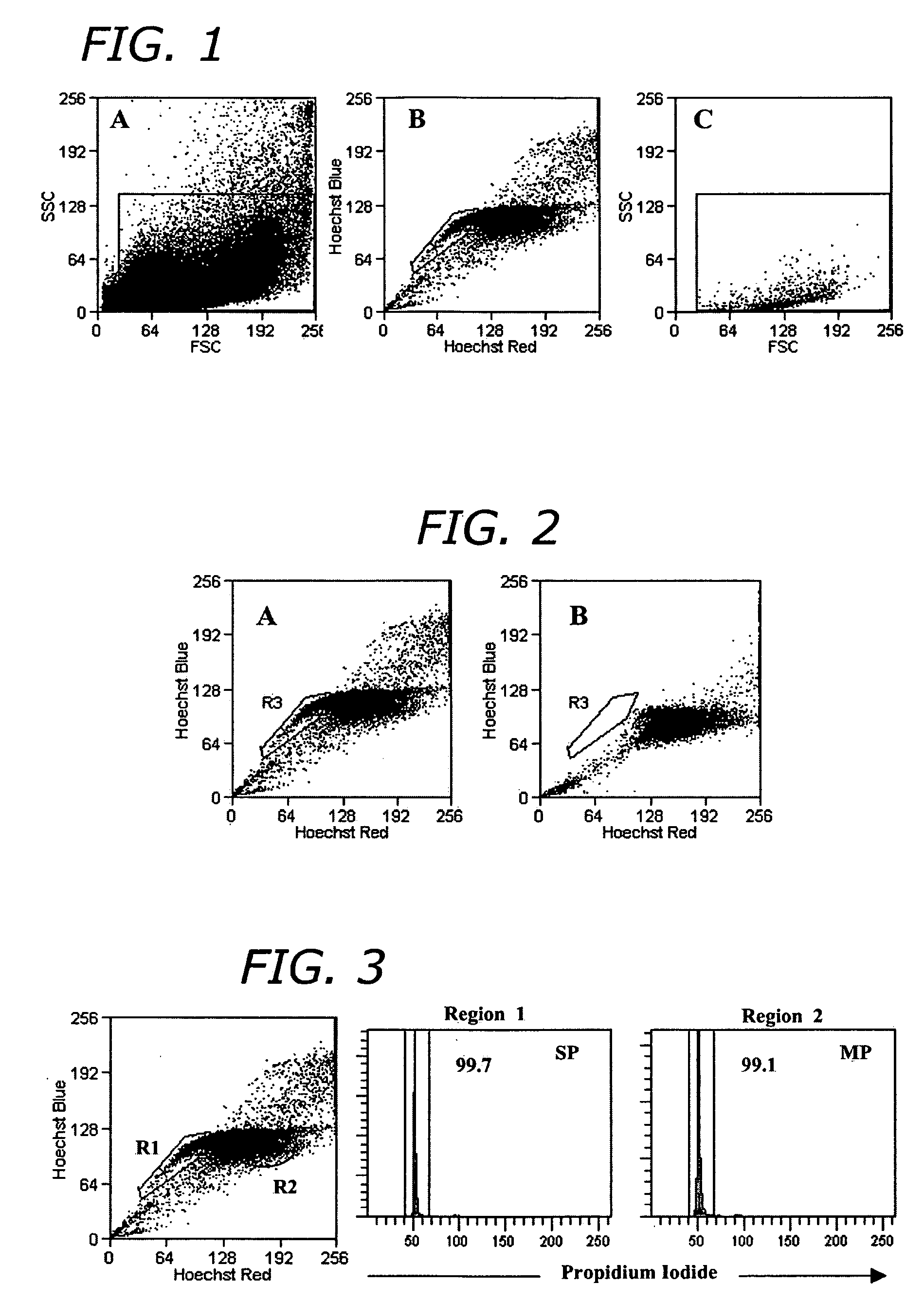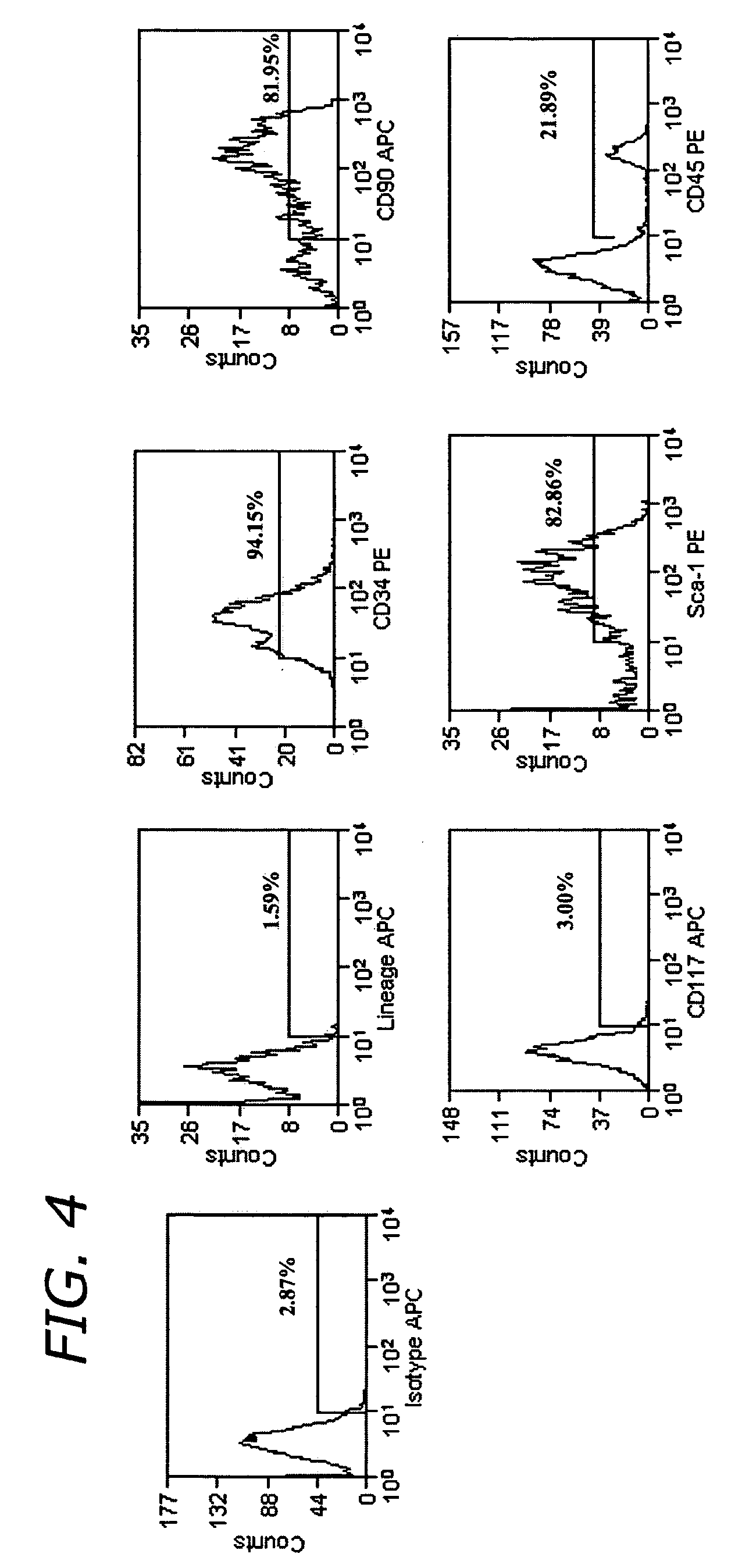Adipose-derived stem cells for tissue regeneration and wound healing
a technology of stem cells and tissue, applied in the direction of skeletal/connective tissue cells, extracellular fluid disorder, peptide/protein ingredients, etc., can solve the problems of inability to fully heal wounds, injury or trauma site remains open, and death due to infection
- Summary
- Abstract
- Description
- Claims
- Application Information
AI Technical Summary
Benefits of technology
Problems solved by technology
Method used
Image
Examples
example 1
Generation and Culture of Adipose-Derived Stem Cells
[0098] This example demonstrates the isolation of adipose-derived stem cells. While the following example described the isolation of adipose-derived stem cells from mouse tissue, it would be possible for a person of ordinary skill in the art to use these techniques to isolate adipose-derived stem cells from other mammalian tissues.
[0099] Briefly, visceral fat encasing the stomach and intestines was removed and finely minced with sterile scissors. The dissected fat was then washed ten times with calcium / magnesium-free Dulbecco's phosphate-buffered saline containing 1 mM EDTA (DPBS(−) / EDTA) and centrifuged at 500 xg for 5 min after each wash step to remove floating adipocytes. The adipose tissue was then incubated in DPBS(−) / EDTA for ten minutes at room temperature and the adipose tissue was then mechanically disaggregated with surgical scissors or with a BD Medimachine (BD Biosciences, San Jose, Calif.). The disaggregated adipose ...
example 2
Identification of Adipose-Derived Stem Cell Side Population Cells
[0101] For adipose-derived stem cell side population cell (ADSC-SP) analysis, adipocytes were suspended in a concentration of 1×106 cells / mL in DMEM with 10% FBS. The cells were incubated with Hoechst 33342 (Sigma) at a final concentration of 2.5 μg / mL. The cells were gently agitated every 20 min in a 37° C. water bath for a total of 90 min. After incubation, cells were pelleted by centrifugation and kept on ice until flow sorting. To demonstrate Hoechst efflux inhibition, cells were incubated with verapamil (Sigma) at a final concentration of 25 μg / mL in addition to Hoechst staining for the same incubation period.
[0102] Sorting was done on a Cytopeia InFlux Cell Sorter (Seattle, Wash.). Hoechst-stained cells were excited with a 355 nm 20 mW UV laser (Lightwave Electronics, Mountain View, Calif.) and Hoechst blue and red emission was separated with a 560 nm dichroic mirror and collected using a 460 / 50 and 670 / 40 band...
example 3
Differentiation of ADSC-SP Cells
[0109] After sorting, cells were washed once with DMEM supplemented with 10% FBS and cultured on a feeder layer of mouse embryonic fibroblast STO cells. The STO feeder cells were plated on dishes coated with 0.1% (wt / vol) gelatin, treated with mitomycin C (Sigma) at a concentration of 10 μg / ml for 2.5 h at 37° C., and washed three times with PBS. Sorted ADSC-SP cells were plated onto mitomycin C-treated STO feeder cells with a daily change of culture medium (FIG. 5).
[0110] To examine the functional capabilities of ADSC-SP cells, they were differentiated into different cell types. For osteogenesis, adipogenesis, and neurogenesis 50,000 cultured ADSC-SP cells at passage four were plated. For chondrogenesis, 80,000 cultured ADSC-SP cells at passage four were plated as a micromass.
[0111] Adipogenesis
[0112] Fifty thousand cells were grown in adipogenic induction and maintenance medium (Cambrex, Walkersville, Md.) according to manufacturer's specificati...
PUM
| Property | Measurement | Unit |
|---|---|---|
| concentration | aaaaa | aaaaa |
| concentration | aaaaa | aaaaa |
| concentration | aaaaa | aaaaa |
Abstract
Description
Claims
Application Information
 Login to View More
Login to View More - R&D
- Intellectual Property
- Life Sciences
- Materials
- Tech Scout
- Unparalleled Data Quality
- Higher Quality Content
- 60% Fewer Hallucinations
Browse by: Latest US Patents, China's latest patents, Technical Efficacy Thesaurus, Application Domain, Technology Topic, Popular Technical Reports.
© 2025 PatSnap. All rights reserved.Legal|Privacy policy|Modern Slavery Act Transparency Statement|Sitemap|About US| Contact US: help@patsnap.com



